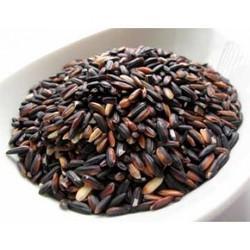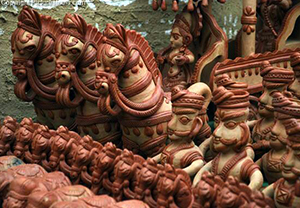Why in news?
Chak-Hao, the black rice of Manipur, the Gorakhpur terracotta, Kovilpatti kadalai mittai have bagged the Geogrphical Indication (GI) tag in 30th April 2020.
Chak-Hao

- Chak-Hao is a scented glutinous rice which has been in cultivation in Manipur over centuries and is characterised by its special aroma.
- It is normally eaten during community feasts and is served as Chak-Hao kheer.
- Chak-Hao has also been used by traditional medical practitioners as part of traditional medicine.
- This rice takes the longest cooking time of 40-45 minutes due to the presence of a fibrous bran layer and higher crude fibre content.
Gorakhpur terracotta

- The terracotta work of Gorakhpur is a centuries-old traditional art form, where the potters make various animal figures like, horses, elephants, camel, goat, ox, etc. with hand-applied ornamentation.
- The entire work is done with bare hands and artisans use natural colour, which stays fast for a long time.
- The craftsmen are mainly spread over the villages of Aurangabad, Bharwalia, Langadi Gularia, Budhadih, Amawa, Ekla etc.
Kovilpatti kadalai mittai

- Kovilpatti kadalai mittai is manufactured in Kovilpatti and adjacent towns and villages in Thoothukudi district.
- Kovilpatti kadalai mittai is a candy made of peanuts held together with glistening syrup of Jaggery and it has a long shelf life and has a huge export potential.
- For decades, the Kovilpatti kadalai mittai was traditionally prepared during village festivals using palm jaggery and groundnuts from nearby districts.
GI Tag
- A geographical indication (GI) is a name or sign used on certain products which corresponds to a specific geographical location or origin (e.g., a town, region, or country).
- India, as a member of the World Trade Organization (WTO), enacted the Geographical Indications of Goods (Registration and Protection) Act, 1999 has come into force with effect from 15 September 2003.
- GIs have been defined under Article 22 (1) of the WTO Agreement on Trade-Related Aspects of Intellectual Property Rights (TRIPS) Agreement as: “Indications which identify a good as originating in the territory of a member, or a region or a locality in that territory, where a given quality, reputation or characteristic of the good is essentially attributable to its geographic origin.“
- The GI tag ensures that none other than those registered as authorised users (or at least those residing inside the geographic territory) are allowed to use the popular product name.
- Darjeeling tea became the first GI tagged product in India, in 2004–2005.
- GI protection systems restrict the use of the GIs for the purpose of identifying a particular type of product, unless the product and/or its constituent materials and/or its fabrication method originate from a particular area and/or meet certain standards.
- Sometimes these laws also stipulate that the product must meet certain quality tests that are administered by an association that owns the exclusive right to license or allow the use of the indication.
Geographical Indications Registry (GIR)
- As per the Geographical Indication of Goods (Registration and Protection) Act, 1999 , association of persons or producers can apply for GIs for specific products supported by required documents.
- The Controller General of Patents, Designs & Trade Marks (CGPDT), (under the Dept. of Industrial Policy and Promotion of Ministry of Commerce and Industry) is the ‘Registrar of Geographical indications’.
- The CGPDT directs and supervises the functioning of the Geographical Indications Registry (GIR).



